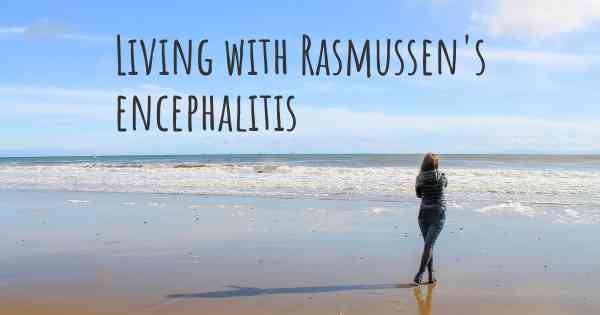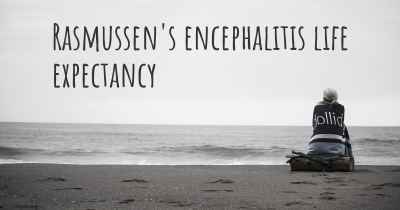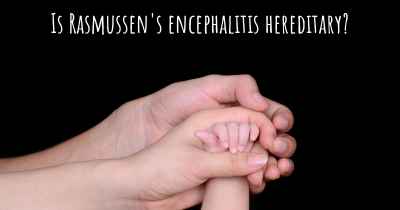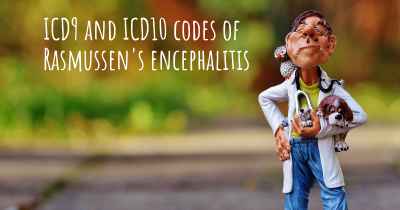Living with Rasmussen's encephalitis. How to live with Rasmussen's encephalitis?
Can you be happy living with Rasmussen's encephalitis? What do you have to do to be happy with Rasmussen's encephalitis? Living with Rasmussen's encephalitis can be difficult, but you have to fight to try to be happy. Have a look at things that other people have done to be happy with Rasmussen's encephalitis

Living with Rasmussen's Encephalitis
Rasmussen's encephalitis is a rare and chronic neurological disorder that primarily affects children. It is characterized by inflammation and progressive damage to one hemisphere of the brain, leading to various symptoms including seizures, cognitive decline, and weakness on one side of the body. Coping with Rasmussen's encephalitis can be challenging, but with proper management and support, individuals can lead fulfilling lives.
Medical Management
Effective medical management is crucial for individuals with Rasmussen's encephalitis. Consulting with a neurologist or epileptologist who specializes in this condition is essential. They can help develop a personalized treatment plan that may include:
- Antiepileptic drugs (AEDs): Medications are often prescribed to control seizures. Finding the right combination and dosage may take time, and regular follow-ups with the doctor are necessary to monitor their effectiveness.
- Immunomodulatory therapies: In some cases, medications that suppress the immune system, such as corticosteroids or immunoglobulins, may be used to reduce inflammation and slow disease progression.
- Surgery: In severe cases, where one hemisphere is significantly affected, surgical interventions like hemispherectomy or functional hemispherectomy may be considered to alleviate seizures.
Seizure Management
Seizures are a common symptom of Rasmussen's encephalitis, and managing them effectively is crucial for improving quality of life. Here are some important considerations:
- Seizure precautions: Identifying triggers and taking necessary precautions, such as getting enough sleep, avoiding stress, and maintaining a healthy lifestyle, can help reduce the frequency and severity of seizures.
- Seizure response: Educate family members, friends, and caregivers about how to respond during a seizure. This includes ensuring a safe environment, timing the seizure, and providing comfort and support afterwards.
- Emergency plans: Develop an emergency plan with your healthcare provider, including when to administer rescue medications, when to seek medical help, and whom to contact in case of an emergency.
Support and Rehabilitation
Living with Rasmussen's encephalitis can be emotionally and physically challenging. Seeking support from healthcare professionals, family, and friends is crucial. Here are some important aspects to consider:
- Psychological support: Dealing with a chronic condition can be overwhelming. Consider seeking therapy or counseling to help cope with the emotional impact of the disease.
- Education and advocacy: Educate yourself and others about Rasmussen's encephalitis to raise awareness and understanding. Connect with support groups or online communities to share experiences and gain valuable insights.
- Rehabilitation: Physical, occupational, and speech therapies can help manage motor and cognitive impairments. These therapies aim to improve functional abilities, enhance independence, and optimize overall quality of life.
Education and Lifestyle
Children with Rasmussen's encephalitis may face challenges in their education. It is important to work closely with educators and school administrators to develop an individualized education plan (IEP) that accommodates their needs. Additionally, maintaining a healthy lifestyle can contribute to overall well-being:
- Healthy diet: Eating a balanced diet can support overall health and well-being. Consult with a nutritionist to ensure adequate nutrition and to address any specific dietary concerns.
- Physical activity: Engaging in regular physical activity, as recommended by healthcare professionals, can help maintain physical strength, improve mood, and reduce stress.
- Rest and self-care: Prioritize rest and self-care to manage fatigue and prevent burnout. Listen to your body's needs and make time for relaxation and activities you enjoy.
Living with Rasmussen's encephalitis requires a multidisciplinary approach involving medical management, seizure control, support, and lifestyle adjustments. While the condition presents challenges, with the right strategies and support, individuals can lead meaningful and fulfilling lives.








